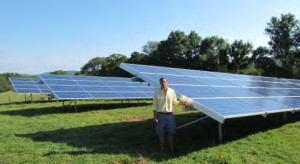 Ten years ago, as the issue of Global Climate Change was emerging as a major world-wide problem, I became interested in solar photovoltaics, a carbon free source of electric generation. Clearly, cost was the major deterrent to solar power and the reason it has not been more embraced by the shortsighted US economy. But with the arrival of government incentives and a few pioneers willing to invest for the long term, the picture began to change. Several companies embraced a business model based on the Power Purchase Agreement (PPA) wherein building owners allowed others to construct solar generating systems on their buildings if they could purchase discounted electricity. Government incentives and the emerging market for carbon credits offered these solar developers and their forward thinking customer-partners acceptable returns. Aware of the small commercial rooftops that are all around us and understanding that small buildings represent a major portion of our electric use, I began to wonder if the PPA model could work on a much smaller scale.
Ten years ago, as the issue of Global Climate Change was emerging as a major world-wide problem, I became interested in solar photovoltaics, a carbon free source of electric generation. Clearly, cost was the major deterrent to solar power and the reason it has not been more embraced by the shortsighted US economy. But with the arrival of government incentives and a few pioneers willing to invest for the long term, the picture began to change. Several companies embraced a business model based on the Power Purchase Agreement (PPA) wherein building owners allowed others to construct solar generating systems on their buildings if they could purchase discounted electricity. Government incentives and the emerging market for carbon credits offered these solar developers and their forward thinking customer-partners acceptable returns. Aware of the small commercial rooftops that are all around us and understanding that small buildings represent a major portion of our electric use, I began to wonder if the PPA model could work on a much smaller scale.
I knew I would need customers who were not likely to move for at least a decade; I wanted to avoid negotiating with the buyers of buildings housing my equipment. Homeowners and small businesses are mobile and move often. On the other hand, non-profits, especially education centers and churches, rarely move. They have loyal communities of people who spread the word about new projects – perfect for my mission of promoting solar power. Non-profits cannot take advantage of tax credits and depreciation deductions. Finally, non-profits are often very aware of environmental issues and interested in ways that help promote solutions.
Connecticut is a friendly state to solar developers, and organizations like New Pond Farm make effective partners in reducing fossil fuel use and the carbon released. Now we need a lot more solar developers like Star Power and a lot more enlightened property owners like New Pond Farm.

Comments are closed.